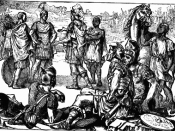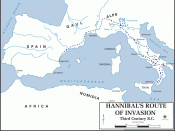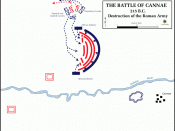Michael Grant's Short History of Rome, the Oxford Classical Dictionary, and Webster's Biographical Dictionary together provide a solid base on which to build a general crosschecked account of Hannibal's life and the Second Punic War. Theodor Hannibal's character, the focus of my future essay, was examined more closely in Mommsen's History of Rome and John Prevas' Hannibal Crosses The Alps. The dictionary sources provide only dry lists of events with no commentary, side notes or analysis. Grant does provide some of his own opinions on Hannibal's character and possible reasons for his eventual defeat, which I will discuss after first drawing out an outline of the Second Punic War.
The Second Punic War, fought between Carthage and the Roman Republic from 218-202 BC, was the final major Carthaginian military opposition to Rome's dominance in the Mediterranean. Hannibal, born in 247 as the eldest son of Hamilcar Barca , was trained under his father's command in Spain, who made him swore eternal enmity to Rome.
After his father's death in 228, he served under his brother-in-law Hasdrubal until his assassination in 221, after which he became the commander in chief of the Carthaginian army in Spain. He quickly adopted his father's war like policy...
The Second Punic War broke out in 218 when Hannibal took control of the Greek city and Roman ally, Saguntum. Both sides were confident in their resources and warriors, so they did nothing to prevent war. Hannibal, leaving 20,000 troops with his brother Hasdrubal, crossed the Alps with 40,000 troops. The treacherous cross cost him 14,000 men, but also caught the Romans by surprise. He encountered unexpected resistance from local tribes that he had hoped would easily provide him more manpower, although he did manage to recruit Gauls. Hannibal won battles at Trebia and at River...


